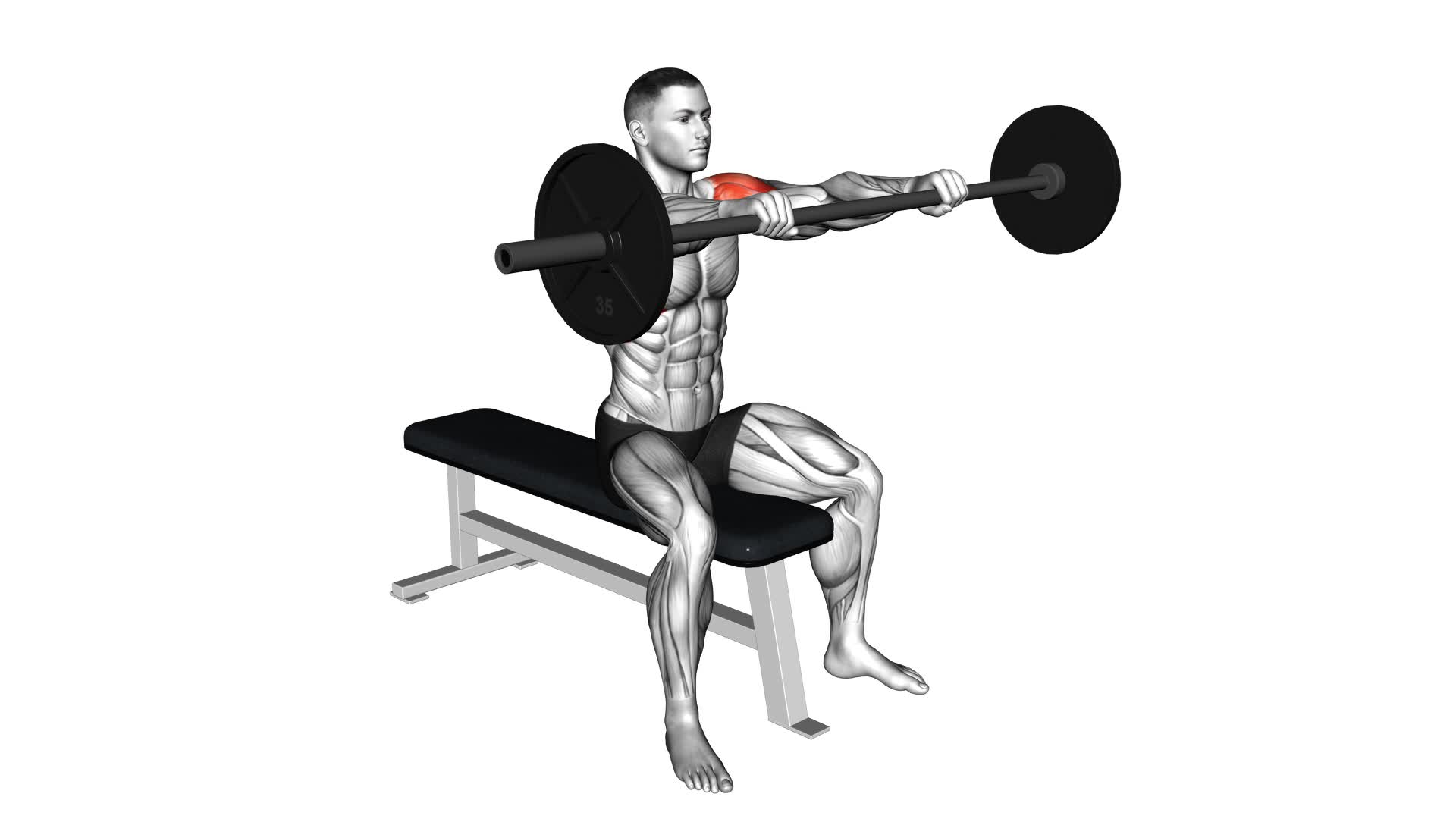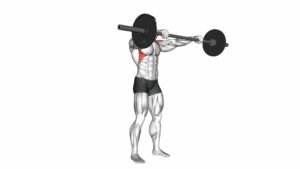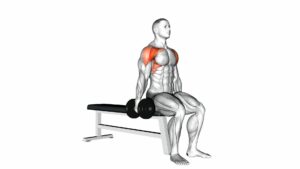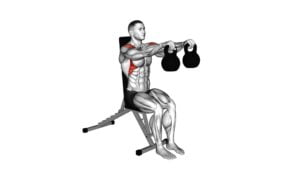Barbell Seated Front Raise – Video Exercise Guide & Tips

Are you looking for an effective shoulder exercise that targets your front delts? Look no further than the barbell seated front raise.
Watch This Exercise Video
This exercise is perfect for building strength and definition in your shoulders. In this article, we'll guide you through the proper form and technique, provide variations and modifications, and share tips for increasing intensity.
Get ready to take your shoulder workout to the next level with the barbell seated front raise.
Key Takeaways
- The barbell seated front raise targets and strengthens the anterior deltoids, improving the front of the shoulders.
- This exercise also enhances shoulder stability and mobility while engaging the upper back and core muscles for proper posture.
- It helps develop balanced shoulder muscles and overall shoulder strength for daily activities.
- Maintaining proper form and technique, including shoulder stability, elbow positioning, and breathing techniques, is crucial for effective engagement of the anterior deltoids.
Benefits of Barbell Seated Front Raise
You can experience several benefits from incorporating the barbell seated front raise into your workout routine. This exercise primarily targets the anterior deltoids, which are the muscles at the front of your shoulders. By performing the barbell seated front raise with proper form and technique, you can effectively activate and strengthen these muscles.
When done correctly, the barbell seated front raise helps to improve shoulder stability and mobility. It also engages the muscles in your upper back and core, as they work to maintain proper posture throughout the movement. This exercise can help to enhance your overall shoulder strength and muscular endurance.
Additionally, the barbell seated front raise can be a great way to isolate and target the front delts specifically. This can be beneficial for individuals who've weak anterior deltoids or are looking to develop more balanced shoulder muscles.
Incorporating the barbell seated front raise into your workout routine can also help with functional movements in your daily life. Strong anterior deltoids are essential for activities such as lifting, pushing, and carrying objects.
Now that you understand the benefits of the barbell seated front raise, it's important to learn about proper form and technique in order to maximize the effectiveness of this exercise.
Proper Form and Technique
To perform the Barbell Seated Front Raise with proper form and technique, there are a few key points to keep in mind.
First, focus on maintaining shoulder stability throughout the movement by engaging your core and keeping your shoulders down and back.
Next, pay attention to your elbow positioning, making sure to keep your elbows slightly bent and in line with your shoulders.
Lastly, use proper breathing techniques to enhance stability, exhaling as you lift the barbell and inhaling as you lower it.
Shoulder Stability Tips
Maintaining proper shoulder stability is crucial for executing the barbell seated front raise with precision and effectiveness. To improve your shoulder stability, incorporate specific exercises into your shoulder strengthening workouts.
These exercises include the plank, side plank, and stability ball push-ups. The plank exercise targets the core and shoulder muscles, while the side plank focuses on the lateral shoulder muscles. Stability ball push-ups engage the stabilizer muscles in the shoulders, enhancing overall stability.
When performing these exercises, ensure that your shoulders are aligned with your wrists and that you maintain a straight body position. Avoid shrugging your shoulders or allowing them to collapse.
Elbow Positioning Tips
To achieve proper form and technique in the barbell seated front raise, focus on maintaining optimal elbow positioning throughout the exercise. Proper elbow positioning plays a crucial role in maximizing the effectiveness of this exercise while also preventing potential injuries.
One common error is allowing the elbows to flare out to the sides, which places unnecessary strain on the shoulder joints. Instead, keep your elbows slightly bent and directly in front of your body throughout the movement. This helps to engage the targeted muscles, primarily the anterior deltoids, more effectively.
As you progress and become more comfortable with the exercise, you can gradually increase the weight and challenge your muscles further. Remember to always prioritize maintaining correct elbow positioning to ensure optimal results and prevent any potential issues.
Breathing Techniques for Stability
For optimum stability and proper form during the barbell seated front raise, focus on controlling your breath through slow and controlled inhales and exhales. Breathing control is essential for maintaining stability and preventing any unnecessary strain during the exercise.
As you lift the barbell, inhale deeply through your nose, filling your diaphragm and engaging your core. This helps to stabilize your body and maintain proper alignment.
As you lower the barbell, exhale slowly and steadily, releasing the air from your lungs while still maintaining core engagement. This controlled breathing technique not only helps you stay stable throughout the movement but also ensures that you're properly engaging your core muscles.
Now that you have a good understanding of breathing techniques for stability, let's move on to discussing variations and modifications for the barbell seated front raise.
Variations and Modifications
Try performing the barbell seated front raise with different grip variations to target your shoulder muscles from various angles. By changing your grip, you can modify the seated front raise exercise to focus on specific areas of your shoulders.
One modification you can try is the wide grip front raise. With a wider grip, you'll engage more of your lateral deltoids, which are the muscles on the sides of your shoulders. This variation can help you develop broader shoulders and enhance your overall shoulder strength and stability.
Another modification is the narrow grip front raise. By using a narrower grip, you'll shift the emphasis to your anterior deltoids, which are the muscles at the front of your shoulders. This variation can help you develop a more defined and sculpted front shoulder appearance.
For those looking for advanced seated front raise variations, you can try using dumbbells instead of a barbell. Dumbbells allow for a greater range of motion and can help improve shoulder stability. Additionally, you can incorporate a pause at the top of the movement or perform the exercise standing instead of seated to further challenge your shoulder muscles.
Remember to always use proper form and start with lighter weights when attempting these modifications or variations. Gradually increase the weight as you become more comfortable and confident with the exercise.
Common Mistakes to Avoid
Avoid these common mistakes when performing the barbell seated front raise exercise. To ensure proper form and maximize the effectiveness of this exercise, make sure to avoid the following:
- Using excessive weight: Using too heavy of a barbell can compromise your form and put unnecessary strain on your shoulders. Start with a light weight and gradually increase as you become more comfortable with the movement.
- Swinging the barbell: It's important to maintain control throughout the exercise and avoid swinging the barbell. This not only takes away from the targeted muscles but also increases the risk of injury. Focus on using a slow and controlled motion.
- Raising the barbell too high: While it may be tempting to lift the barbell as high as possible, it's important to remember that the goal of this exercise is to target the front delts. Raising the barbell too high can shift the emphasis away from the intended muscles. Aim to raise the barbell to shoulder level and no higher.
Tips for Increasing Intensity
To increase the intensity of the barbell seated front raise, there are a few different methods you can incorporate into your workout routine.
One option is to use resistance bands. These bands are a great tool for adding resistance and increasing difficulty to your exercises. To use them, start by attaching the resistance band to a sturdy anchor point, such as a squat rack or door frame. Then, hold the ends of the resistance band with your hands while sitting on a bench or chair. As you perform the barbell seated front raise, the resistance bands will provide additional resistance throughout the movement, challenging your muscles even more.
Another way to increase the intensity is to use heavier weights. As you become stronger, gradually increase the weight of the barbell. This will require your muscles to work harder to lift the weight, leading to increased difficulty and muscle growth.
For advanced modifications, you can try performing the barbell seated front raise on an unstable surface, such as a stability ball or Bosu ball. This will engage your core muscles and challenge your stability, making the exercise even more intense. Additionally, you can perform the exercise using a single arm instead of both arms, which will further increase the difficulty and target each side of your body individually.
Remember to always listen to your body and progress at your own pace. It's important to challenge yourself, but also to avoid overexertion or injury.
Incorporating Barbell Seated Front Raise Into Your Shoulder Workout
Now that you have learned the proper form techniques for the barbell seated front raise, it's time to incorporate this exercise into your shoulder workout routine.
By adding the barbell seated front raise, you can effectively target your front deltoids and strengthen your shoulder muscles.
This exercise is also suitable for beginners, as you can start with lighter weights and gradually increase the intensity as your strength improves.
Proper Form Techniques
Start by gripping the barbell with an overhand grip, positioning your hands slightly wider than shoulder-width apart. This will help activate your shoulder muscles effectively during the exercise. To ensure proper form and avoid strain, follow these tips:
- Sit on a bench with your back straight and feet flat on the ground.
- Keep your core engaged and maintain a neutral spine throughout the movement.
- Slowly raise the barbell in front of you until your arms are parallel to the floor.
- Avoid using momentum or swinging your body to lift the weight.
- Control the movement on the way down to fully engage your muscles.
- Start with lighter weights and gradually increase as you become comfortable with the exercise.
Variations for Beginners
Incorporate the barbell seated front raise into your shoulder workout routine with these variations for beginners.
If you're just starting out, it's important to modify the exercise to suit your fitness level. One beginner modification is to use lighter weights or even just a barbell without any additional weight. This will help you focus on proper form and build up your strength gradually.
Another alternative exercise is the dumbbell front raise. Instead of using a barbell, hold a dumbbell in each hand and lift them up in front of you. This variation allows for more control and can be less intimidating for beginners.
Remember to start with lighter weights and gradually increase as you become more comfortable with the movement.
Frequently Asked Questions
How Many Sets and Reps Should I Do for the Barbell Seated Front Raise?
For the barbell seated front raise, it's important to start with the current question: how many sets and reps should you do?
The answer depends on your fitness goals and experience level. Generally, aim for 3-4 sets of 8-12 reps to build strength and muscle.
If you're a beginner, start with lighter weights and fewer reps. As you progress, gradually increase the weight and reps.
Remember to maintain proper form and technique throughout the exercise.
Can I Use Dumbbells Instead of a Barbell for This Exercise?
Yes, you can definitely use dumbbells instead of a barbell for the seated front raise exercise. This dumbbell substitution offers several benefits.
Firstly, using dumbbells allows for greater range of motion, targeting different muscles in your shoulders.
Additionally, it helps improve stability and balance as each arm works independently.
Lastly, dumbbells provide a variety of weight options, allowing you to customize the intensity of the exercise based on your fitness level and goals.
Is the Barbell Seated Front Raise Suitable for Beginners?
The barbell seated front raise is a great exercise for beginners. It helps to strengthen your shoulders and upper body.
The barbell allows for more variation in your workout routine, as you can adjust the weight according to your fitness level. Incorporating the barbell seated front raise in your routine will improve your posture and help prevent shoulder injuries.
It's a simple yet effective exercise that will give you noticeable results.
Should I Perform This Exercise With a Slow or Fast Tempo?
When performing the barbell seated front raise, you have the option to choose between a slow tempo or a fast tempo. The tempo you choose will depend on your goals and preferences.
Performing the exercise with a slow tempo can help to increase time under tension, which can lead to muscle growth and strength gains.
On the other hand, performing the exercise with a fast tempo can help to improve power and explosiveness in the shoulders.
Ultimately, the choice between a slow or fast tempo is up to you and what you want to achieve with the exercise.
Can the Barbell Seated Front Raise Help Improve My Posture?
The barbell seated front raise can definitely help improve your posture. By targeting the muscles in your shoulders, upper back, and core, this exercise strengthens the muscles responsible for maintaining proper posture.
It also helps to open up your chest and improve shoulder mobility. Incorporating the barbell seated front raise into your routine along with other exercises for improving posture can have long-term benefits for your overall posture and alignment.
Conclusion
To summarize, the barbell seated front raise is a beneficial exercise for strengthening and toning the shoulders.
By maintaining proper form and technique, you can effectively target the front deltoids.
Variations and modifications allow for customization based on individual fitness levels.
Avoiding common mistakes and incorporating intensity-boosting tips will maximize the effectiveness of this exercise.
Adding the barbell seated front raise to your shoulder workout routine can help you achieve your fitness goals.

Author
Years ago, the spark of my life’s passion ignited in my mind the moment I stepped into the local gym for the first time. The inaugural bead of perspiration, the initial endeavor, the very first surge of endorphins, and a sense of pride that washed over me post-workout marked the beginning of my deep-seated interest in strength sports, fitness, and sports nutrition. This very curiosity blossomed rapidly into a profound fascination, propelling me to earn a Master’s degree in Physical Education from the Academy of Physical Education in Krakow, followed by a Sports Manager diploma from the Jagiellonian University. My journey of growth led me to gain more specialized qualifications, such as being a certified personal trainer with a focus on sports dietetics, a lifeguard, and an instructor for wellness and corrective gymnastics. Theoretical knowledge paired seamlessly with practical experience, reinforcing my belief that the transformation of individuals under my guidance was also a reflection of my personal growth. This belief holds true even today. Each day, I strive to push the boundaries and explore new realms. These realms gently elevate me to greater heights. The unique combination of passion for my field and the continuous quest for growth fuels my drive to break new ground.







